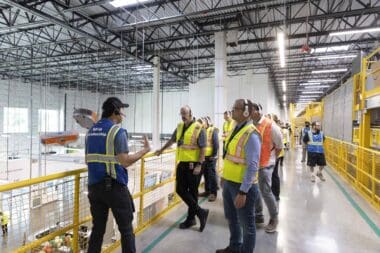Exploring Automation and Culture at Amazon
From garage to global giant: how innovation, data and machine learning drive Amazon’s BFI4 Fulfillment Center

Nearly 30 years ago, in a Seattle-area garage, Jeff Bezos and the few employees of his upstart online retailer, Amazon, knelt on the floor to pack customer orders into boxes. One evening, Bezos suggested ordering kneepads to make the work more comfortable. One of his workers respectfully disagreed and suggested they order packing tables instead – an option that proved to be better for worker satisfaction and throughput. This early example of centering durable needs, rather than immediate or short-term needs, exemplifies the culture of innovation that now permeates Amazon.
During MLC’s sold-out tour of Amazon’s BFI4 Fulfillment Center cohosted by Amazon Business and Amazon Web Services, participants got a behind-the-scenes look at how the company sorts and packages thousands of items per day for delivery to customers. The tour also provided insights into Amazon’s approach to data, supply chain and procurement, offering a deep dive into the progression of the company’s culture from its early days.
During his presentation on the culture of innovation, Clint Schneider, Amazon Web Services’ Digital Innovation Lead for Smart Factories, shared how culture, mechanisms, architecture and organization lead to better innovation. Schneider explained how Amazon’s decision-making process uses the concept of “one-way” or “two-way” doors to make high-quality, high-velocity decisions. A one-way door represents a significant decision like should Amazon build a new facility, while a two-way door represents something less critical, like changing the buy button’s color.
Using the one-way versus two-way door analysis helps the company innovate faster with a bias for action. If it is a two-way door, they know they do not have to deliberate as long. Instead, they can run the experiment and move back through the door to adjust or revert if the decision does not produce the intended results and ROI.
Automation and Innovation at Amazon’s BFI4 Fulfillment Center
“This is what we manufacture,” Julius Yu, General Manager of Amazon’s BFI4 Fulfillment Center shares as he holds one of the thousands of packed boxes filled with a customer’s order that move by the MLC tour group as they walk through the facility. “Everything we manufacture here is unique.”

BFI4 handles millions of units per week, each with a distinct mix of “parts” that are sorted, picked, packed, inspected, sealed, labeled and distributed for delivery. BFI4 is Amazon’s eighth iteration of an Amazon robotics fulfillment center. In total, BFI4 has thousands of mobile robots storing and transporting products between stations where they are manually sorted for storage then picked and packed for delivery.
At the sort station, employees put items into random bins for storage until a customer orders the product. Using a vision system, a camera takes a picture of where the item has been randomly placed so that it can be retrieved and transported via AMR to the pick station when ordered.
After the product is ordered and delivered to the pick station, a control panel tells employees where it is located on the rack so they can move it into a bin to be packed into a customer’s box. Computer vision verifies the number of items in each bin, taking pictures to ensure accuracy.
Harnessing Data to Improve Efficiency
Data, data management, and data contextualization are integral to operations at BFI4. The company generates terabytes of data to ensure end-to-end transparency. Machine learning helps determine which fulfillment center or distribution center across the country should house each product, using historical ordering patterns with about 60% accuracy. These determinations help to improve delivery speeds, and have resulted in more efficient delivery routes. While machine learning hasn’t helped Amazon achieve 100% accuracy yet, Yu is optimistic that advancements in technology, computing power and artificial intelligence will improve precision.
One notable innovation using data is a custom box maker. For orders that include a single item, Amazon’s machine will custom cut cardboard to create a shipping box. The custom box maker relies on product data to determine the correct size of the box so that it can fit snug around the product. The downstream benefits are significant. The company can fit more boxes into trucks, for example, which is a positive for both sustainability and throughput.
An Immersive Amazon Experience
Participants enjoyed a networking reception the evening prior to the tour featuring entertainment by Washington-based 2019 American Idol contestant Kazmyn, food options from local vendors, and a trip to Amazon’s iconic Banana Stand – all hosted in Amazon’s Spheres, an innovative coworking space. The reception gave participants an opportunity to network with fellow tour participants and Amazon ambassadors while immersed in a unique Amazon workspace ecosystem.

Following the tour, attendees engaged with a panel of Amazon experts including Julius Yu, Brian Steward (Director of Worldwide Amazon Business Operations), and Mobeen Khan (Director, Global Business Development and Partnerships), facilitated by MLC’s Senior Content Director, Penelope Brown. The panelists addressed questions about the BFI4 facility, data, culture, safety and Amazon’s processes.
The Amazon tour experience concluded with a session titled “Manufacturing at Amazon: The Future, Faster, Together,” covering three pillars for manufacturing’s future: data as a foundation, AWS supply chain, and strategic procurement.
For participants, the tour proved to be a fascinating opportunity to see how far Amazon has come since those earliest days when employees packed customer orders in a garage and where the company’s culture of innovation may lead it in the future.